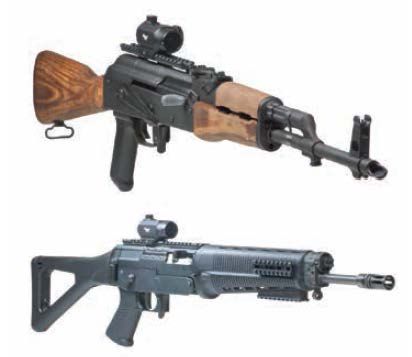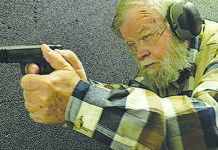With all of the political focus on guns, and specifically semiauto AR-style rifles, shooting enthusiasts have been trying to get their hands on products that are durable enough to last through any of the troubles that might be coming. For this task, the AK-47 platform may be the best place to start. Known for durability and reliability, the AK-47 has been tagged “the rifle of the revolution.” If you have ever seen a movie that has bad guys in it, you have probably seen them carrying a AK-47. There are videos all over the internet of people doing crazy things with their AKs, such as shooting them in pools, firing so many rounds through them at a fast enough pace to set the front end on fire, burying them and pulling them out of the ground and firing them, and the list goes on and on.

We picked out two vastly different AK-style rifles for a head-to-head Gun Tests showdown: The WASR-10 imported by Century International Arms and the 556 Russian (556R) made by Sig Sauer. At first glance, the Century International Arms WASR-10 7.62x39mm, $900 (online pricing from GanderMountain.com), looks like a classic AK design, but it has some refinements American shooters will prefer. The WASR-10 is a post-ban version of the AKM rifle. WASR stands for Wassenaar Arrangement Semiautomatic Rifle. The name comes from a Dutch town where the international agreement on exportation of small arms was born. As manufactured in Romania, the 7.62×39 mm GP WASR-10 accepts single-column 10-round magazines. At the Century International Arms factory, the rifles are modified to conform with Title 18, Chapter 44, Section 922(r) of the United States Code. After arriving in the U.S., the rifles are disassembled, the magazine wells are machined out to accept double-stack magazines, and the requisite number of U.S.-made parts are installed for BATF compliance. With enough domestic parts included to make it “officially” U.S. made, the rifle can have a pistol grip and accept high-capacity magazines. The added U.S. parts are: 1) gas piston, 2) trigger, 3) hammer, 4) disconnector, 5) buttstock, and 6) pistol grip. Some units also have Tapco plastic folding or collapsible stocks. Beginning in 2007, Century International Arms has installed the Tapco Intrafuse AK G2 trigger group to eliminate trigger slap. These rifles come supplied with two 30-round magazines and a bayonet lug.
In contrast, the mostly polymer 556R looks like something out of a science-fiction movie. The Sig 556R is a revised version of the original rifle chambered in 7.62x39mm, most commonly referred to as the Gen 1. While there was never an official recall announced by Sig, the company will stand by the Gen 1 gun and make the corrections needed to get the gun up to par. One of the ways that you know whether you have a Gen 1 or a Gen 2 is that the Gen 2 has a steel-reinforced magazine shelf. One of the Gen 1’s problems was that metal magazines commonly used with AK-47s would wear down this shelf over time and cause the magazine not to sit correctly, or in some cases not even stay seated in the magazine well. Another issue that a lot of users reported were failures to eject. If you compare the size of the ejection port on the Gen 1 next to a Gen 2, you will notice that the Gen 2 has a much wider opening, allowing shells to eject without catching and causing a problem. The final issue on Gen 1s that owners reported were failures to fire. To solve this in the Gen 2s, Sig apparently increased the hammer-spring strength to make sure the harder primers in Russian ammo would ignite.
The good news is this: when Sig fixes a problem, they really fix it. The Sig 556R that we used in this test has all of the modifications already made, and it is just as reliable as every other AK out there, we believe. With its hefty price tag (going for nearly $3000 in some listings early in 2013), we wanted to see if the Sig was worth the money, or if the handy shooter is better off buying a less expensive model like the WASR-10 and making his own adjustments as time and necessity require and money allows. Here’s what we thought of the two rifles compared point by point:
Cosmetics & Fit and Finish
An all-black plastic and metal presence gives the 556R a sleek look common to AR-15s and which seems to be in such high demand. Exterior fit is camouflaged, in a way, since the handguards butt up against the receiver and the folding stock pops onto the back of the receiver. There’s minor looseness to the fit of all the parts, our inspection showed. The lower half of the action wiggles a tad, the buttstock wiggles a tad, and the handguards wiggle a tad, but there was nothing alarming.
Like the AKM rifle, the WASR has a stamped receiver, ribbed top cover, and a gas tube without vent holes. The fixed stock was also reminiscent of an AKM. It was made from laminated wood, and the forend matched well enough. The lower forend lacked the raised swells of the AKM design. The quality of Parkerizing on the WASR-10 was even and thorough, with just a few wear marks here and there, but mainly where the safety lever moved up and down. The underlying metalwork was satisfactory, we thought, and in fact looked smoother than most other AKs we’ve examined.
Our Team Said: As far as appearances go, the Sig is light-years ahead of the utilitarian WASR-10, in our opinion.
Accouterments
The Sig’s Swiss folding buttstock allows the user to shorten the length of the rifle, which is ideal for tactical situations. Some WASR-10s come with folding or telescoping stocks, but not ours. That would be a prime upgrade we’d perform on a WASR-10, because the Sig’s ribbed-plastic recoil plate was superior to the WASR’s wood stock and sheet-metal buttplate. Of course, the WASR’s buttplate also had a hole in it to allow access to a storage channel cut into the stock that is designed to hold cleaning kits, so that you always have one with your gun when you need it. Needless to say, after firing hundreds of rounds through the WASR-10, our shoulders were more than a little sore.
We preferred the grip on the Sig as well. The ergonomics were better, our testers said, and it had more girth to it, which made it easier to get a grip on. It was textured in a striped pattern on the left and right sides of the pistol grip and was smooth on the back. The bottom of the grip also extends further, which facilitates the ease of maintaining a grip. The hard plastic grip on the WASR was a little too thin and not textured in a manner that was easy to hold on to. The grip had a checkered pattern on both sides and was smooth on the front and the back.
The Sig’s flattened polymer operating handle felt better than the plastic-covered steel knob on the WASR, we thought. For accessories, the Sig also had three built-in removable polymer Picatinny rails, two 2.5-inch-long strips on the sides and a 3-inch-long rail on the bottom. For sights, there was a built-in top rail (with a cutout machined for the pop-up rear sight) and a red-dot sight. Also, the 556R came with a bolt lock and an ambidextrous flip safety.
The flip safety is a nice touch; it is not as cumbersome as the safety on the WASR-10. You can easily flick it with your finger to make the rifle ready to fire or on safe. Its smooth design is also much easier on your fingers when operating the rifle. Another plus is that the safety is ambidextrous, and if you don’t mind the brass coming out in front of your face, the gun can be shot left- or right-handed.
The WASR’s exterior was rough, and after a day of shooting, our hands became pretty raw in places. The safety on the WASR-10 was also very stiff and requires a good amount of force to raise and lower.
The final cool piece on the Sig’s receiver is the action lock. It is a feature that does not come standard on a lot of AKs. When you go to the shooting range, the RO usually wants the gun on the rack, with the action open so that he can easily see that the gun is safe. While sticking a spent piece of brass in the action to keep it open is an ok solution, it is not always ideal. With the Sig, if you pull the action open, there is a little lever on the middle of the left-hand side that, when pressed down, locks the action open. If you keep the gun loaded in your house or on your property, this gives you the ability to see that the action is clear.
The front handguard on the Sig was all plastic, helping maintain the rifle’s light weight.
Our Team Said: The Sig Sauer 556R has a much better accessories package. However, the WASR comes with two magazines rather than the Sig’s single 30-round stick.
Sights
The sights on the WASR were good enough for most field shooting. The post front was adjustable with a special tool for elevation, and by drifting for windage. The rear ladder sight had white-painted numbers ranging from 1 to 10. The rear notch was well mated to the front sight and presented an excellent sight picture. Older eyes will like the placement of the rear sight far out on the gun, making it easier to get into focus. However, that placement also reduces sight radius.
The Sig’s receiver has a Picatinny rail on top that accepts the included Sig Sauer Mini Red Dot Sight. One of the downsides of the 556R is that it does not come with a full set of iron sights. It has a flip-up rear sight but no front sight. The top of the receiver near the gas valve is dovetailed and requires a special base to affix a front sight. Sig lists a Rotary Diopter Rear & Hooded Front Sight Set for $142 on the website, but the front sight wasn’t listed separately, so we’re not sure it would be the right height to work with the existing flip-up rear sight tab. However, there are numerous third-party companies that make sights that will fit, such as the SIG 556 Folding Front Sight from Midwest Industries (#MI-556-FFS, $90). It’s height-compatible with AR-15 rear sights.
As we noted, the Sig came with the excellent Mini Red Dot Sight (STS-081, $199), so to level the playing field, we bought a Midwest Industries AK Side Railed Scope Mount (CheaperThanDirt.com, #7-MIAKSM, $109) and shot the WASR with the same dot sight. The MI scope mount fits on the rifle using the built-in receiver rail interface and puts a Picatinny rail over the top of the rifle. It snaps into place using an auto-locking system that allows for no-tool adjustment and repeat zero locking. So with the mount and dot sight, our $900 base WASR package would be in the $1200 range.
Our Team Said: The Sig arrives with the red dot in place, and there’s no question that’s a better sighting system than the WASR-10 offers. If the red dot works, of course. The WASR-10’s sights won’t ever need batteries. But the Sig’s top rail makes it optics ready, whereas the WASR requires you to buy a scope mount. Neither situation is ideal.
Takedown
This operation on the WASR-10 was easy. Clear the gun, close the bolt, leave it cocked, press the rear button and remove the action cover. Take out the recoil spring assembly, move the bolt fully rearward, and lift it out of the gun. To remove the bolt from its carrier, push the bolt fully rearward, turn it a quarter turn clockwise, and remove it toward the front. The gas-tube assembly, which includes the top piece of the forend wood, is easily removed by rotating a lever to the right of the rear sight. The hammer can be lowered to get better access to the bottom of the receiver for cleaning. We thought the parts inside this gun were well-enough made, though not as smoothly polished or quite as well machined as those on the Sig. Reassembly was a simple reversal of the above. Make sure the hammer is cocked first.
To field-strip the 556R, unload the rifle and visually and physically check to ensure the rifle is clear of all ammunition. Ensure the bolt is forward and retract the takedown pin (rear pin). This pin is captured and does not fully remove. Then remove the pivot pin (forward pin) and unscrew the pivot pin screw (left side) and remove the pivot pin from the trigger casing. Separate the trigger casing from the receiver, then depress the charging-handle catch and remove the charging handle. Next, using the charging handle, push the bolt carrier assembly to the rear and remove it from the receiver. Rotate the bolt head counterclockwise until the lug clears the cam and pull to remove it from the bolt carrier. Pull the lower hand guard to the rear and down and remove. Lift the upper hand guard at the rear and pull it away from the gas block. Depress the stop pin and hold. Rotate the gas valve to the left and pull forward to remove, then push the operating rod assembly forward and remove from the gas tube. Depress the stop pin and rotate the gas tube to the left 90 degrees until the gas tube notch faces the barrel, and remove the gas tube from the gas block.
Our Team Said: The WASR-10 is easier to break down.
Accuracy
We shot both guns for accuracy outdoors at 100 yards with partly cloudy skies and variable light on the targets. Wind was 10 to 15 mph from 6 o’clock, simplifying windage adjustments. Because the Sig lacked iron sights, we used the Sig Sauer Red Dot sight that was provided with the 556R to test both guns. We shot the Sig first with three different types of ammo: Hornady 123-grain Super Shock Tips, Winchester 123-grain full metal jackets, and TulAmmo 122-gr FMJs. Our all-in average group size with the Sig was about 2.2 inches. The average group size for all three types of ammunition with the WASR-10 was 2.7 inches, but the TulAmmo shot a best-of-test 1.4-inch average in the WASR.
Our Team Said: Matching ammo to a particular gun is always a trial-and-error process, but in this case, the WASR won the lottery and clearly shot the best with one of our test ammos. That gave it the edge over the Sig.
Function and (No) Failures
The main complaint about WASR-10s seems to be the lack of magazine-stabilizing dimples on the side of the action, coupled with an occasional failure to function correctly. In place of the dimples, the inside of the action has bits of steel spot-welded in place to accomplish what the dimples used to do. Our magazines went into and slipped out of both rifles with no failures of any kind.
Our Team Said: A toss up.
Our Picks
Both of these AK-47s tested great. Neither gun had any malfunctions while testing, and they were both very accurate. As a finished product, the Sig Sauer 556 Russian comes out of the box ready to shoot, but it’s not really an AK — it’s a Sig 556 that shoots the 7.62x39mm round. And that’s okay if you’re the kind of guy who just has to have the tie that matches the shirt. In this case, we would rather buy the lower-ranked and slightly cheaper CIA WASR-10 and upgrade it to exactly our liking. Based on the numbers for things that we would like to change on our WASR-10, we expect to add about $250 to $300 in rails, buttstock, and handguards and have an AK that is demonstrably still an AK.
Written by John Taylor, using evaluations from Gun Tests team testers. Photography by GT Staff. GT


















